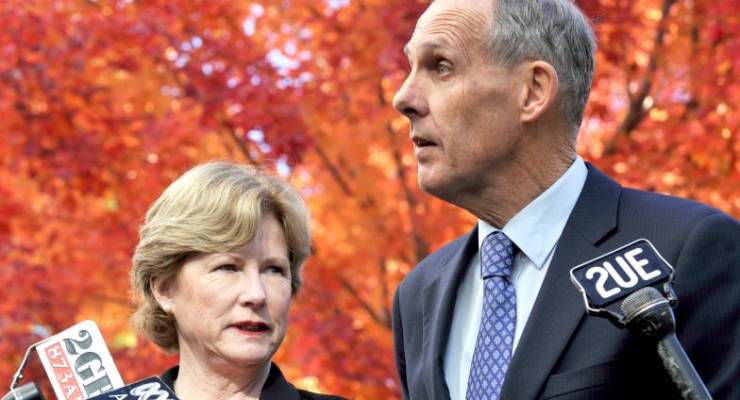
A quarter of the way through Paddy Manning’s detailed history of the Greens we reach the Getting Together conference when, in Easter 1986, the various strands of green politics in Australia resolutely failed to coalesce into a national party.
In Inside The Greens, Manning (who previously worked at Crikey) reports the debate as various groups attempted to mold the party’s philosophy. The real problem to be fought, argues one attendee, “is the patriarchal ego”, while another says an early draft of the credo is too “eco-human-centred”. Both are defensible positions, and both sound like a parody of left-wing politics.
I was reminded of the recent Israel Folau farrago. Various left-wing writers and activists, largely on Twitter, had worthy, thoughtful and completely exhausting arguments about whether the real issue was homophobia, workers’ rights, racism, colonialism or erasure. Meanwhile, a conservative government, with bipartisan support, was getting its religious freedoms narrative into every major news outlet, and well on its way to the floor of parliament. But isn’t that the problem with a sincere desire to make the world a better place? There are so many problems, how does one get consensus on the most urgent. The tensions facing any party trying to define and achieve “progress” is a recurring theme in Manning’s text.
Inside the Greens takes us through the 1970s and 1980s, the incipience of the party. It moves from the steady growth since the party’s federation, to the current mixture of federal stability (or stagnation, depending on who you ask) and state level calamity in Victoria and New South Wales.
The book starts with flooding of Tasmania’s Lake Peddler, dammed for a uneconomic hydro scheme (also the state’s biggest employer). Manning calls the failure of the United Tasmania Group (featuring a young doctor called Bob Brown) to stop the damming the “Gallipoli” of the green movement, the defeat in which an identity was formed. The imagery of a pristine natural wonder, disappearing beneath a human-made flood, a decision based on bad economics and bullish politics has a queasy resonance — particularly after the “climate election” resulted in anti-climax for the Greens in particular, and calamitous failure of progressive politics in general.
It’s not the last time such parallels emerge. At the very foundation of the party are many of the maladies that afflict them today. Should the Greens be grassroots outsiders or respectable professionals? What to do about the perpetually recalcitrant NSW branch? Should the sole focus be the Greens’ raison d’être, protection of the environment, particularly now? Or does there need to be a broader focus on citizens’ day-to-day concerns? What does the famously white, middle-class party do about race and class?
In this way, and others, the book is a catalogue of dilemmas, both moral and practical. At the very heart of it all is the formulation put forward by the ANU’s Ross Garnaut around the time of the 2009 vote on the Carbon Pollution Reduction Scheme (CPRS), the danger that the party make the “best” the enemy of the good. The generally accepted consensus, put forward particularly by Labor, is that, through their naive ideological purity, the Greens voted down a perfectly good carbon pricing scheme, and inflicted the decade of inaction we’ve just seen on the country.
The book attempts to deflate that view somewhat, but it remains a hugely consequential decision. There were many factors that led to the ousting of Kevin Rudd and the initiation of the bizarre musical chairs routine prime minsters have engaged in since. But one of these factors was undoubtedly the Greens refusal — justified, according to some at this publication — to give Rudd a victory on the CPRS to take to the ill-fated Copenhagen Summit. It’s the most stinging example of the classic accusation leveled at the Greens: they’d rather feel righteous and achieve nothing than sully themselves with any compromise. Whether or not that’s true, the Rudd/Gillard/Rudd era wounded the relationship between the two left parties, possibly irreparably.
Manning’s work is a monumental effort — he’s interviewed more than 150 people from the party’s history. His general affection for his subject is at times fairly explicit, and sometimes to the book’s detriment. The phrase “not that they received any credit for it” is never far from a discussion of their achievements and the unequivocal assertion that Australia would be “richer and safer” if Green foreign policy had been followed seems an oversimplification.
Still, this largely doesn’t disfigure Manning’s straightforward, factual approach. Over nearly 500 pages, Inside the Greens stays readable and on the right side of forbidding. And by exploring the tensions of the party beyond the environment — it goes into great detail about the Greens’ response to issues of defence, industrial relations and emerging technological challenges, among other areas — Inside the Greens manages to be not just a fine resource on a single party, but of the times that produced them.








Charlie! Lake Peddler?
Yes The Greens have made plenty of political mistakes. So has the Coalition and Labor. What gets lost in all this hand-wringing analysis of The Greens is that they at least strive to be human and adhere to a generally humanist philosophy. Compare that the the corporate arse-licking of the Liberals, the deep corruption of the Nats and the confused personality of Labor since the advent of neo-liberalism.
I have no time for the Greens ‘ideological purity’. All they have done is stop the progressive side of politics from forming government…or wrecking the short time they have had in government (Rudd/Gillard)…for well over a decade now.
Since the majority of Greens members/voters were formally in the ALP camp, I think the above statement is accurate.
And where is this ideological purity leading the Greens? Stuck on 10% of the vote nationally, which if converted to Labor votes would see them in power, and achieving much more along the lines of what the Greens aspire to. Is that a perfect outcome? NO! But let’s face it ANYTHING is better than what we have now.
Politics is the art of the possible…a fact that the Greens do not seem to grasp!!
Sorry…’formerly’…NOT formally!
A lot of that 10% does get converted to Labor votes via the count of preferences. This year the combination of Labor first preferences was so low that Greens second preferences weren’t enough to rescue them.
We have preferential voting – while not all the 10% would flow to labour this argument does seem a little disingenuous.
Maybe you just mean in Queensland?
“Stuck on 10% of the vote nationally, which if converted to Labor votes would see them in power, “
CML I think you need a refresher in how preferential voting works.
Thanks for the review Charlie. I wouldn’t regard the climate election as you call it an anti climax for the Greens whose vote improved. Please remember they were campaigning for themselves not as a sidekick outfit to get Bill into the lodge. The result was hardly a disaster. The LNP went from a slim majority to a slightly less slim one. The Senate was always going to smooth out after two elections from a double dissolution.
What an odd caption to the pic – would it not have been better put as “Former Greens Leader Christine Milne and her predecessor Bob Brown“?